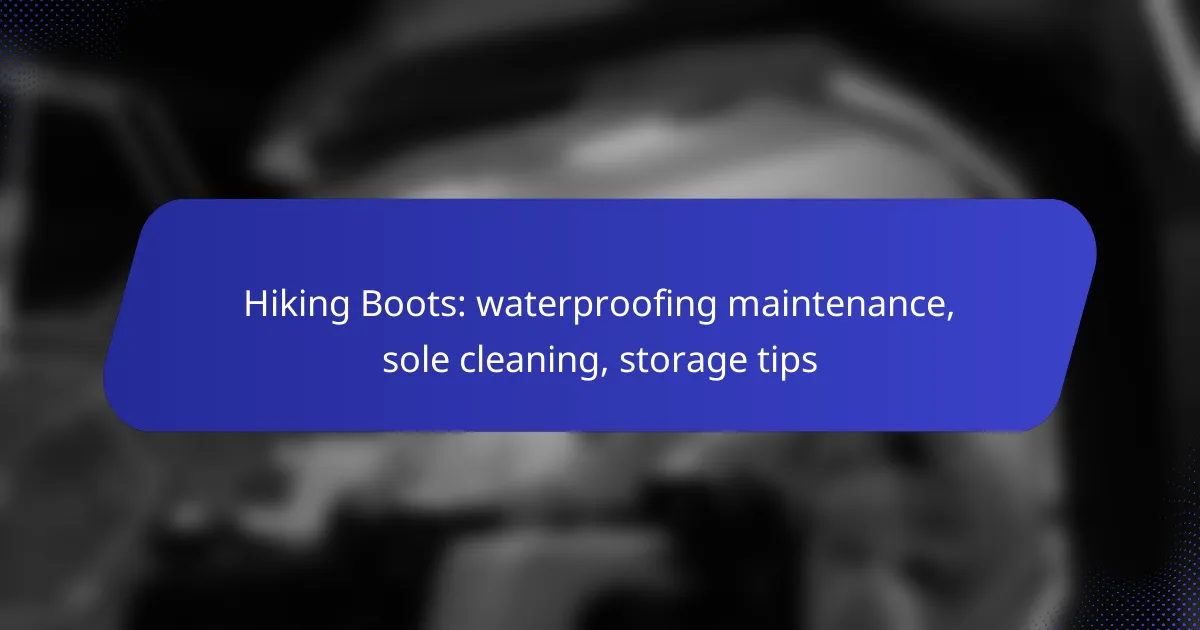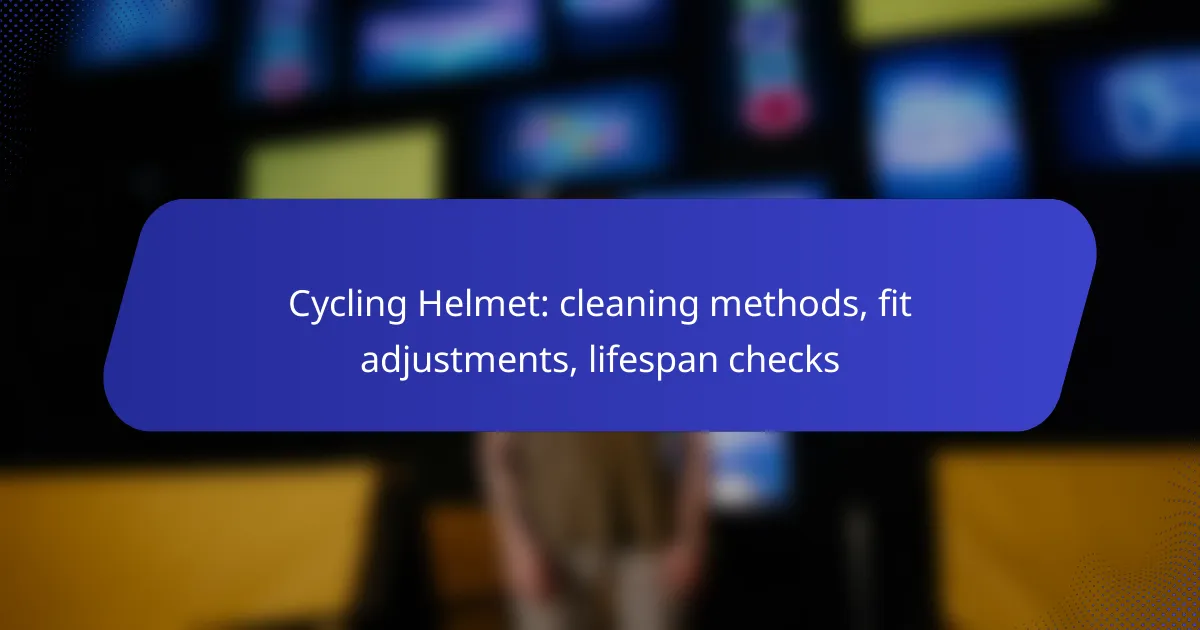Maintaining your running shoes is essential for both their appearance and performance. Effective cleaning methods tailored to the shoe’s materials can prolong their lifespan, while regular sole inspections help ensure safety and comfort during your runs. Additionally, proper storage techniques can further enhance the durability of your footwear.

How to clean running shoes effectively?
Cleaning running shoes effectively involves using the right materials and methods to maintain their appearance and performance. Regular cleaning not only enhances their look but also prolongs their lifespan, ensuring they remain comfortable and supportive.
Use mild detergent and water
Start by mixing a small amount of mild detergent with warm water. Avoid harsh chemicals, as they can damage the shoe materials. Use this solution to wipe down the upper part of the shoes, focusing on any stains or dirt buildup.
For particularly stubborn stains, let the detergent solution sit for a few minutes before scrubbing. This allows the cleaner to penetrate and lift the dirt more effectively.
Employ a soft brush for scrubbing
A soft brush, such as an old toothbrush or a specialized shoe brush, is ideal for scrubbing your running shoes. Gently scrub the shoe’s surface, paying special attention to the seams and textured areas where dirt tends to accumulate.
Be cautious not to use stiff bristles, as they can scratch or damage the material. For the soles, a firmer brush can be used, but ensure you do not apply excessive pressure.
Air dry away from direct sunlight
After cleaning, allow your running shoes to air dry naturally in a well-ventilated area. Avoid placing them in direct sunlight, as this can cause fading and damage to the materials.
To speed up the drying process, you can stuff the shoes with newspaper or paper towels to absorb moisture. Replace the paper as it becomes damp to help maintain the shape and prevent odors.

What are the best cleaning methods for different materials?
The best cleaning methods for running shoes depend on the materials used in their construction. Proper techniques can extend the life of your shoes while maintaining their appearance and performance.
Mesh running shoes cleaning tips
For mesh running shoes, start by removing the laces and insoles. Use a soft brush or cloth to gently scrub away dirt and debris, focusing on the mesh areas without damaging the fabric.
A mixture of mild soap and water works well for deeper cleaning. Dip a cloth into the solution, wring it out, and wipe the shoes. Avoid soaking them, as excess water can affect the shoe’s structure.
After cleaning, air dry the shoes away from direct sunlight to prevent fading or warping. Replacing the insoles and laces after they dry will help restore their original look.
Leather running shoes care
Leather running shoes require a different approach to cleaning. Begin by wiping off any dirt with a damp cloth. For tougher stains, use a leather cleaner specifically designed for athletic footwear.
Conditioning the leather is essential to maintain its suppleness. Apply a leather conditioner every few months to prevent cracking and to keep the material looking fresh.
Store leather shoes in a cool, dry place and avoid exposing them to extreme temperatures. Using shoe trees can help maintain their shape and prevent creasing when not in use.

How to inspect the soles of running shoes?
Inspecting the soles of running shoes is crucial for maintaining performance and safety. Regular checks can help identify wear and damage that may affect your running experience.
Check for wear patterns
Wear patterns on the soles indicate how your foot strikes the ground and can reveal whether your shoes are still providing adequate support. Look for uneven wear, especially in high-impact areas like the heel and forefoot.
Common patterns include excessive wear on the outer edges or the center of the sole. If you notice significant wear, it may be time to replace your shoes to prevent injuries.
Look for cracks and damage
Cracks and other forms of damage can compromise the integrity of your running shoes. Inspect the soles for visible cracks, splits, or any separation between the sole and the upper part of the shoe.
Even small cracks can lead to larger issues, such as reduced cushioning and support. If you find any damage, consider repairing or replacing the shoes to ensure optimal performance and safety during your runs.

What are the signs of worn-out running shoes?
Worn-out running shoes exhibit several key signs that indicate it’s time for a replacement. These signs include a noticeable reduction in cushioning and uneven tread wear, both of which can affect your comfort and performance while running.
Reduced cushioning feel
When the cushioning in your running shoes diminishes, you may notice a harder impact with each step. This reduction can lead to discomfort and increase the risk of injury, as your feet and joints absorb more shock. If you find yourself feeling more fatigue or soreness after runs, it may be a sign that your shoes are losing their cushioning.
A good rule of thumb is to replace running shoes after approximately 300 to 500 miles, depending on your weight, running style, and the shoe’s construction. Regularly check the midsole for compression marks or cracks, which indicate diminished cushioning.
Uneven tread wear
Uneven tread wear is another clear indicator that your running shoes may need replacing. Inspect the outsole for signs of wear patterns, such as excessive smoothing or unevenly worn areas, which can affect your stability and traction. This wear often reflects your running gait and can lead to imbalances that increase the risk of injury.
To assess tread wear, look for areas where the rubber has thinned significantly or where the original tread pattern is no longer visible. If you notice that one side of the shoe is wearing down faster than the other, it may be time to consider a new pair to maintain proper support and alignment during your runs.

How to store running shoes properly?
Proper storage of running shoes extends their lifespan and maintains their performance. Keeping them in the right environment helps prevent damage from moisture, heat, and pressure.
Keep in a cool, dry place
Storing running shoes in a cool, dry location is essential for preserving their materials and structure. Ideal temperatures are typically between 15°C and 25°C (59°F to 77°F). Avoid areas with high humidity, as moisture can lead to mold and deterioration.
Consider using a shoe bag or box that allows for some airflow, which can help keep them dry. If you live in a humid climate, adding silica gel packets to the storage area can further reduce moisture levels.
Avoid stacking shoes
Stacking shoes can cause deformities and damage to the soles and uppers. Instead, store each pair separately to maintain their shape and cushioning. Use a shoe rack or individual boxes to keep them organized and accessible.
If space is limited, consider using vertical storage solutions that keep shoes upright without pressure on the materials. This method not only protects the shoes but also makes it easier to find the pair you need when you’re ready to run.

What are the benefits of proper shoe maintenance?
Proper shoe maintenance significantly enhances the durability and performance of running shoes. Regular cleaning, inspection, and appropriate storage can prevent premature wear and ensure optimal functionality during runs.
Extended lifespan of shoes
Maintaining your running shoes can greatly extend their lifespan, allowing you to get the most value from your investment. Regular cleaning removes dirt and debris that can degrade materials, while inspecting the soles for wear helps identify when it’s time for replacement.
To maximize longevity, store your shoes in a cool, dry place away from direct sunlight. Avoid leaving them in damp areas, as moisture can lead to mold and deterioration. Aim to clean your shoes after every few runs, especially if you run on trails or in muddy conditions.
Improved running performance
Proper maintenance of running shoes can lead to improved performance by ensuring that the shoes provide adequate support and cushioning. Worn-out soles can affect traction and stability, which may hinder your running efficiency.
Regularly inspecting the soles for signs of wear, such as uneven tread or reduced cushioning, is crucial. If you notice significant wear, consider replacing your shoes to maintain optimal performance levels. Keeping your shoes clean also helps in maintaining their original grip, which is essential for safe running on various surfaces.

What tools can assist in shoe cleaning and maintenance?
Various tools can enhance the cleaning and maintenance of running shoes, ensuring they remain in good condition. Key items include specialized cleaning kits and waterproofing sprays, which help preserve the shoe’s material and functionality.
Shoe cleaning kits
Shoe cleaning kits typically contain brushes, cleaning solutions, and microfiber cloths designed specifically for different shoe materials. These kits can effectively remove dirt, stains, and odors, extending the life of your shoes.
When selecting a cleaning kit, consider the type of material your shoes are made from, such as mesh, leather, or synthetic fabrics. Some kits may include eco-friendly cleaners, which are a good choice for those concerned about environmental impact.
To use a cleaning kit, follow the instructions carefully. Generally, you’ll want to brush off loose dirt first, apply the cleaner, scrub gently, and then wipe with a damp cloth. Avoid soaking your shoes, as excessive moisture can damage them.
Waterproofing sprays
Waterproofing sprays create a protective barrier on the shoe’s surface, helping to repel water and stains. This is particularly beneficial for running shoes used in wet or muddy conditions, as it can prevent material degradation.
When choosing a waterproofing spray, look for one that is compatible with your shoe’s material. Some sprays are designed for specific fabrics, while others are more versatile. Always test the spray on a small, inconspicuous area before full application to ensure it does not alter the color or texture.
To apply waterproofing spray, clean your shoes first, then hold the spray can about 6-12 inches away and apply an even coat. Allow the shoes to dry completely before wearing them. Reapplication may be necessary after several uses, especially if the shoes are frequently exposed to wet conditions.

What are common mistakes in running shoe care?
Common mistakes in running shoe care include using harsh cleaning methods, neglecting sole inspection, and improper storage. These errors can lead to reduced shoe lifespan and performance, ultimately affecting your running experience.
Using harsh chemicals
Using harsh chemicals can damage the materials of running shoes, leading to deterioration and reduced performance. Many cleaning products contain strong solvents that can break down the shoe’s structure, especially in breathable mesh and rubber components.
Instead of harsh chemicals, opt for mild soap and water for cleaning. A gentle solution can effectively remove dirt without compromising the integrity of the shoe. Always test any cleaning solution on a small area first to ensure it does not cause discoloration or damage.
When cleaning, use a soft brush or cloth to avoid scratching the surface. Regular maintenance with gentle methods can extend the life of your running shoes significantly, allowing you to enjoy your runs without worry.



